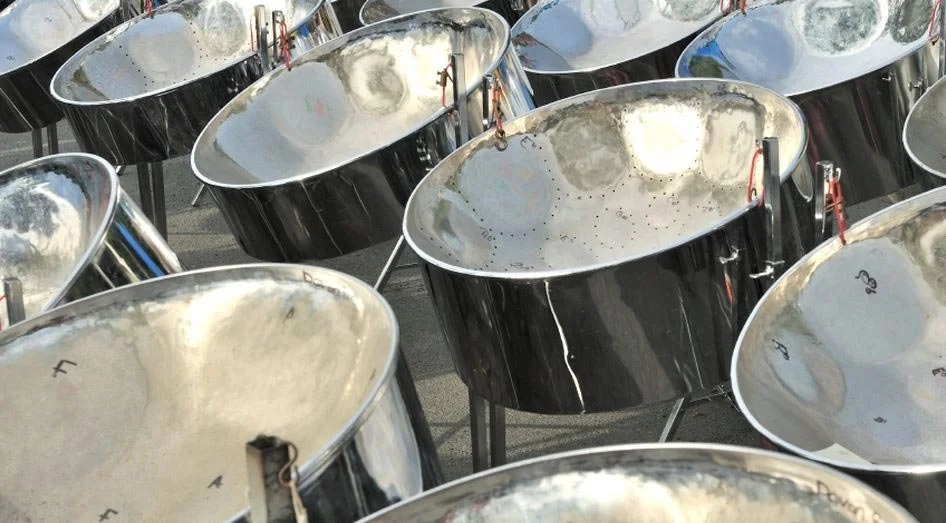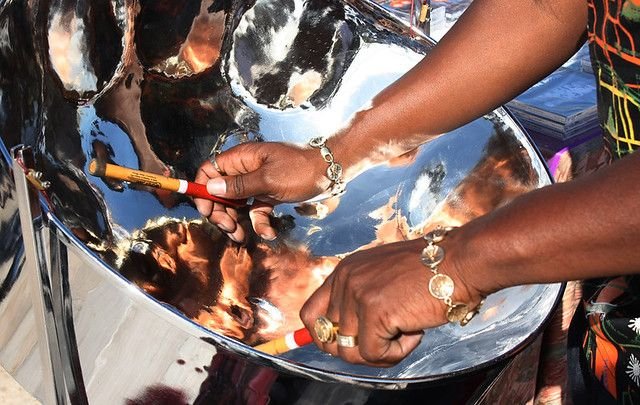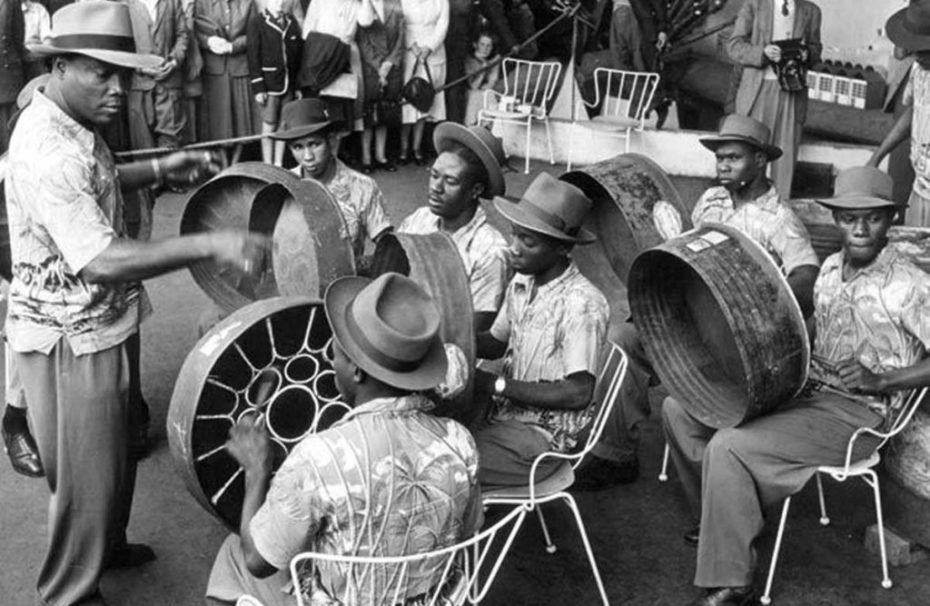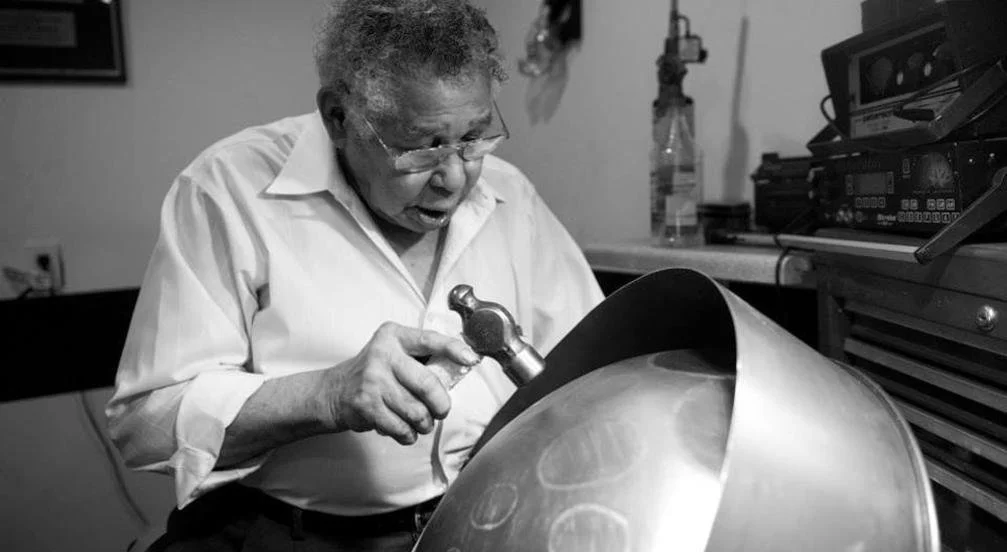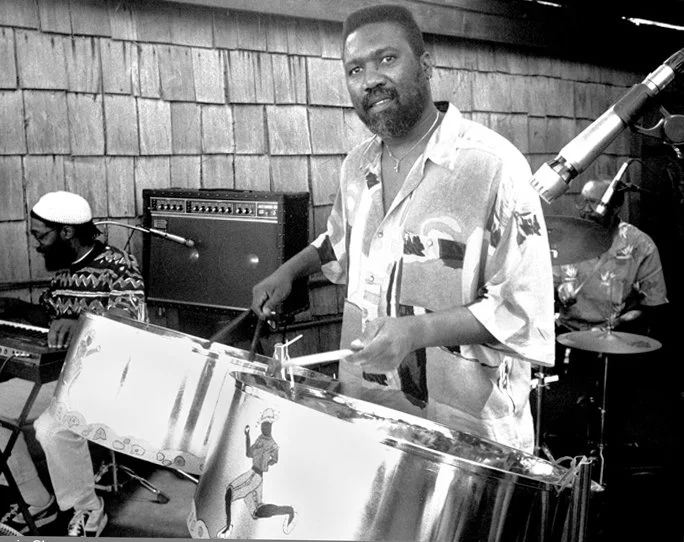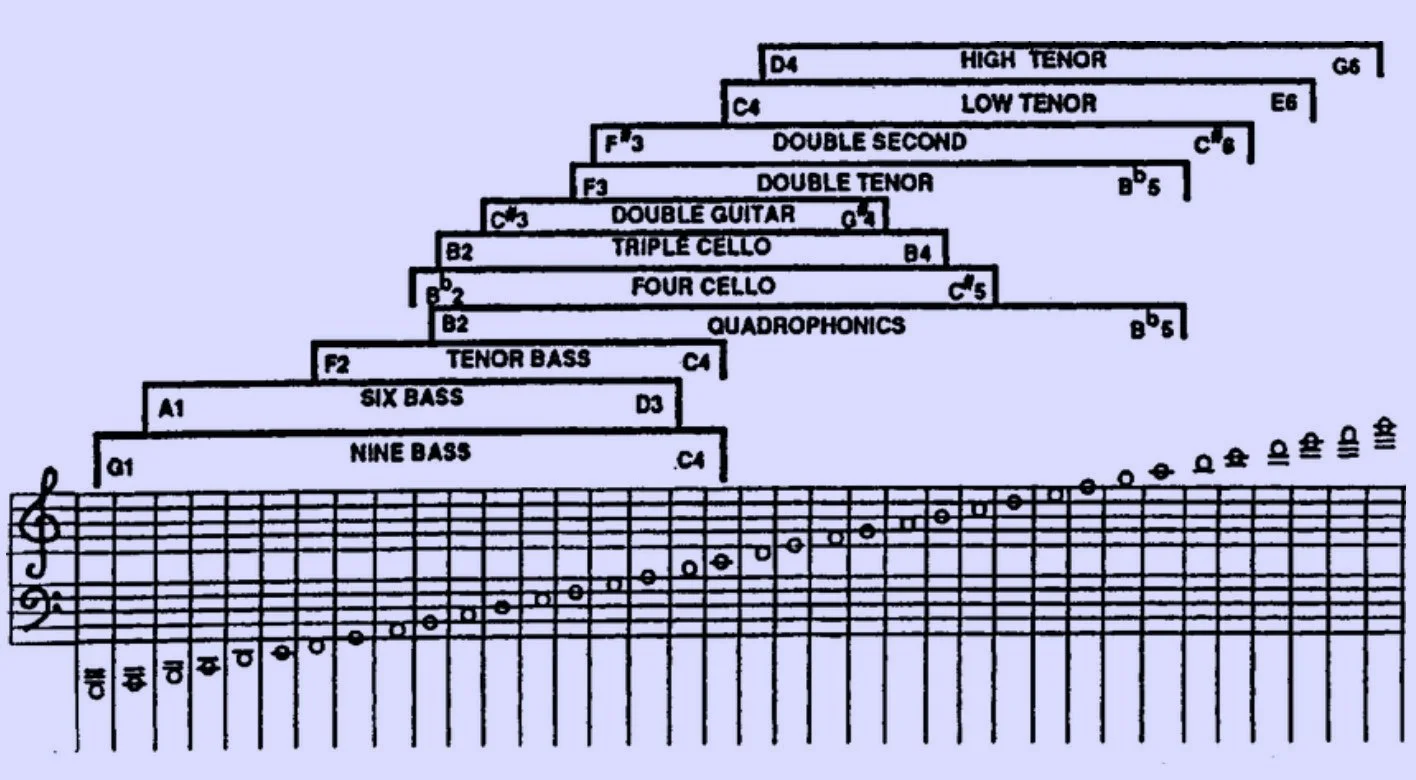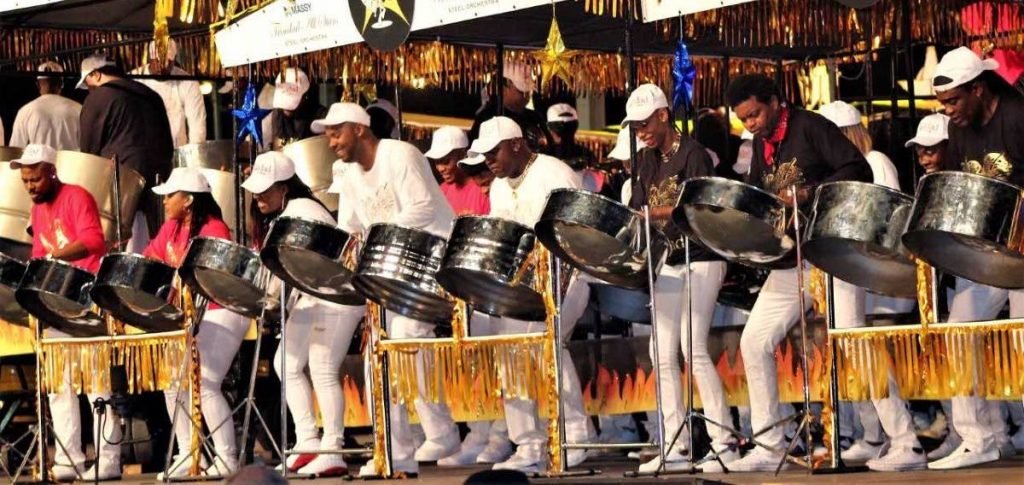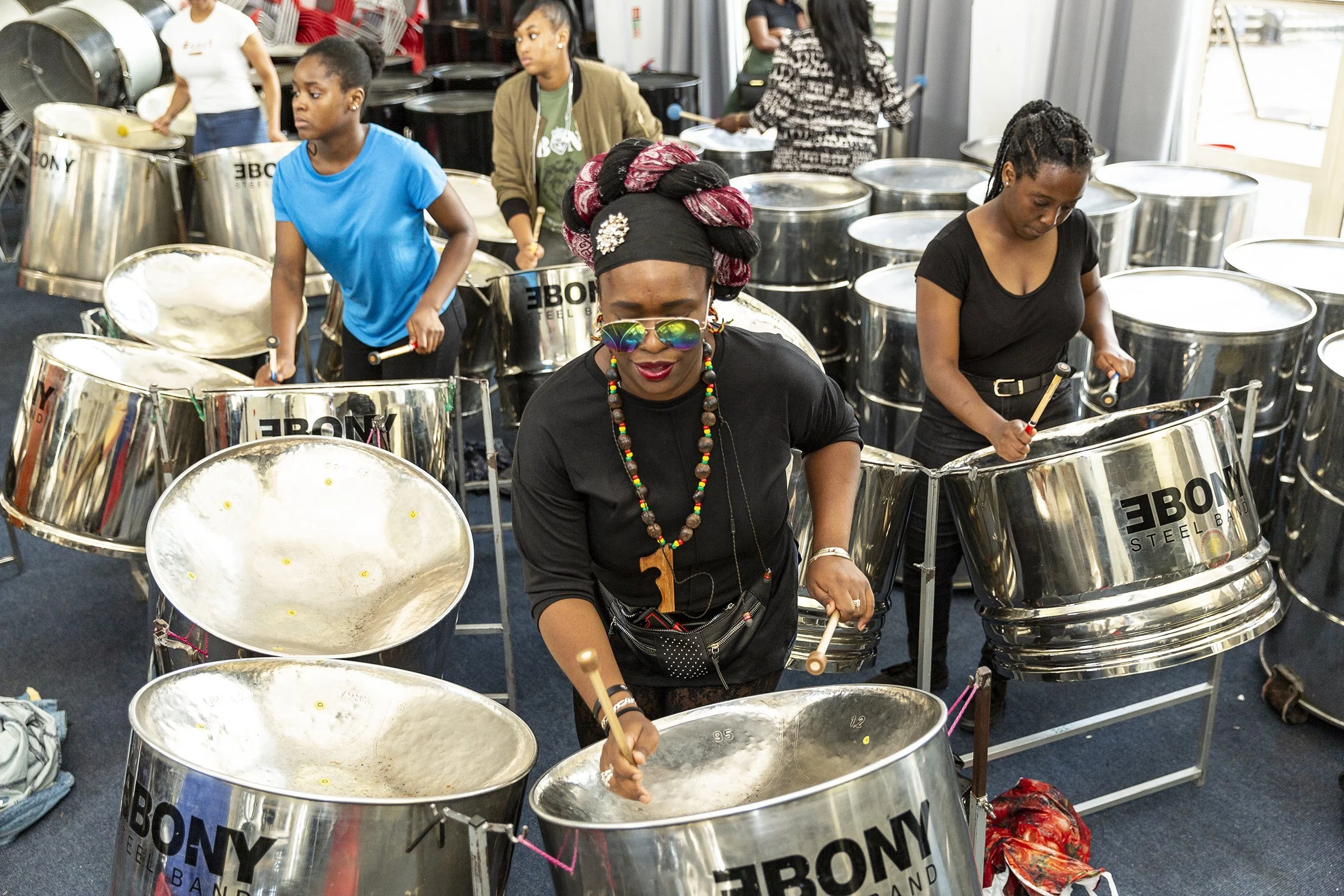Precision hitting
By The Landlord
“It huddled there
steel tinkling its blue painted metal air,
tempered in violence, like Rio’s Favelas,
with snaking, perilous streets whose edges fell as
its Episcopal turkey-buzzards fall
from its miraculous hilltop
shrine,
down the impossible drop
to Belmont, Woodbrook, Maraval, St Clair.” – Derek Walcott, Laventille
“Its specificity is that of steel
Rounded and pounded and concave
… it belches melodiously
Chromed plated, seldom gold plated.
… Who is that, that calls to me, so
Fervently from Trinbago,
In rhythmic sounds and harmony? In perfect mix,
They flick their wrists with rubber head sticks,
Upon disc of steels, and whisk sweet sounds.” – Curtis Greasley, The Steel Pan Artiste (for Desmond Waithe)
They tremble, warmer than bells, brighter than bang or hum of drum, evoking sunshine and smiles, calypso, Trinidad & Tobago, but there’s far more to their beautiful striking precision, with origins dark and defiant. So it’s steel pan or steel drum week, a musical palate cleanser, uplifting for spirits, bringing a different timbre to the old or familiar, and a special colour to the new. So, then, it’s time to chime with a new tone, strike a chord, ring out a melody, in solo or ensemble, with any song or piece of music in which the steel pan or steel band features fully or in a significant role, particularly in original material, or where the sound mixes in original ways with other instruments and voices, or where other tunes are covered and brought afresh.
Developed in the 1930s, steel pan has very much a backstory of a culture forced into and then rebellion against slavery, using circumstance and whatever material is available to keep older customs alive. Within that sweet sound is comes a story of suffering, resistance, freedom and triumph.
Steel pan’s spirit grew out of the talking drums of West Africa. Sometimes called steel drums, they aren’t drums per se, or any other skin-covered membranophone, but are from the idiophone family, and came down from the defiance of inhabitants taken from that part of the world onto slave ships to the Caribbean, families often separated not only for exploitation, but to destroy culture. While slaves toiled on plantations in Trinidad & Tobago, French colonists in the 1780s began to hold mock African festivals in which they would often black up, dress up in costumes and bang drums. In turn, the African slaves began underground carnivals of their own, hidden in cabins and backyards, using masks, feathers, beads, and perhaps more quietly, their own drumming.
But that was violently repressed, and in 1789, Spanish governor of Trinidad José María Chacón officially imposed Catholicism and its trappings, customs and holidays on the black population to curb older culture, but in response African rhythms would resurface in secret, Africans still wearing their Sunday best.
Even after 1834, with the Slavery Abolition Act, and emancipation arrived in Trinidad & Tobago, segregation still continued, but a counterculture still thrived, with the growth and celebration of Canboulay, a harvest festival centred around calypso drumming. But the cycle of repression and response continued. All African drumming, as well traditional stick fighting, was band in 1881, sparked by the Canboulay riots during that year’s festival. Bamboo stick drumming, called tamboo bamboo arose from that, but any bands were regularly subject to more bans.
Yet music will always defy the odds using whatever materials are available, and former slaves began to reach for anything to play music, such as a gin bottle and spoon. But that was never good enough, and by the mid-1930s, metal percussion was taking over, incorporating such items as a car brake hub, known as an iron, or the biscuit drum, called “the boom” from which calypso rhythms take their name. New instruments began to be fashioned from metal containers, tuned and shaped with hammers.
In 1937 a steel band competition held at Queen’s Park Oval in Trinidad, with Alexander's Ragtime Band the winner, and by the 1940s items such as a 55-gallon oil drum was a primary material to make steel pan instruments. Eventually members of the Trinidad All-Steel Pan Percussion Orchestra (TASPO) became the pop stars of the pan, and played at the Festival of Britain in 1951.
Trinidad players mesmerise crowds at the Festival of Britain in 1951
Steel pan instruments, played by “pannists”, now come in huge variety of sizes and and pitches, created by many pioneers and heroes of the instrument, mostly born and brought up in Trinidad and who have been the inspiration of music in other genres. That includes Winston "Spree" Simon, born in Laventille, as in the title of Derek Walcott’s poem above, a pioneer who created instruments from kettle drums, in particular the resonant single tenor, or ping pong steel pan, which had a high, lead melody soprano pitch. Van Dyke Parks even made a musical tribute to Spree, inventor, as well as a legendary pannist. Here’s a video including footage and interviews about the early days and Spree’s role in it:
Another huge figure in the development of steel pan is Elliott Anthony "Ellie" Mannette, born in Sans Souci, Trinidad in 1927, who lived until he was 90, and created many models, such the invader lead pan, but some of which incorporated several integrated instruments including the double second, quadduet, triple guitar, cello, tenor bass and six bass, all of which extended the range and could cover roles of those instruments by association.
Legendary inventor and player Elliott Anthony "Ellie" Mannette
Other key names to listen out for are Tony Williams, Bertie Marshall and Rudolph Charles, and players and composers such as Lennox “Boogsie” Sharp, Ray Holman, Liam Teague, and Russ Henderson (who settle in the UK) all from Trinidad, but who have all inspired many other musicians from other parts of the world to master the instrument, often in jazz, many American including Andy Narell, Andy Akiho, Othello Molineaux (who played with Jaco Pastorius), and Jonathan Scales.
Len “Boogsie” Sharp
Steel pan can touch on any genre. The annual World Steelband Music Festival, held in Trinidad since 1964 requires steelbands to perform an test piece (original composition or a selected calypso); a piece of their own choice (very often a "classic" or European work) and calypso of choice usually played in a tempo known as “The Bomb”. But beyond calypso, jazz or classical, steel pan might interpret pop, rock hip hop, dance music, soul, funk, country or anything else with a melody or harmony enhanced by its special flavour, and outside the leading proponents, fans of the instrument include a very diverse set of artists from Beach Boys to Beastie Boys, Jane’s Addiction to Damon Albarn, Hot Chip to The Hollies, Killers to Kinks, Marlon Roudette or Mark Ronson to Rush, Taylor Swift to Stephen Stills.
Perhaps that’s in part because range of the instrument is vast. Here’s a table to show what it covers, generally bigger the pan, the lower the tone.
Many pans can play a variety of notes, often arranged chromatically, and with the pannist, using a stick with a rubber end, needing the strike it in precisely the correct place. Here’s an example:
Note map of for a double second pan pair
But without getting stuck further into the technicalities, let’s just get stuck into the sounds and the songs. Listening out for all the hits and more, and whatever will hopefully resonate, is returning guest in the chair Loud Atlas! Place your steel pan numbers in comments below before the big one is struck at 11pm UK time for last orders on Monday, and playlists published next week. It’s time for pans, and inspiration, to strike.
Trinidad competition
`Ebony Steel Band
New to comment? It is quick and easy. You just need to login to Disqus once. All is explained in About/FAQs ...
Fancy a turn behind the pumps at The Song Bar? Care to choose a playlist from songs nominated and write something about it? Then feel free to contact The Song Bar here, or try the usual email address. Also please follow us social media: Song Bar Twitter, Song Bar Facebook. Song Bar YouTube, and Song Bar Instagram. Please subscribe, follow and share.
Song Bar is non-profit and is simply about sharing great music. We don’t do clickbait or advertisements. Please make any donation to help keep the Bar running:

